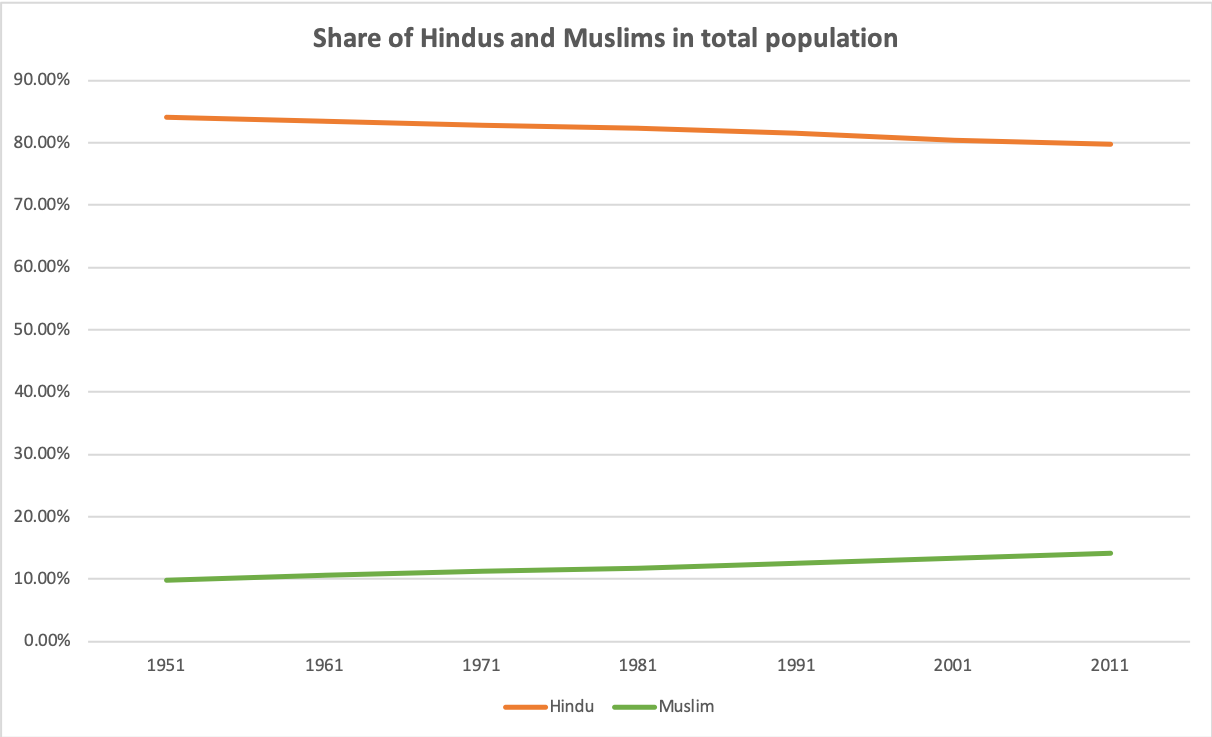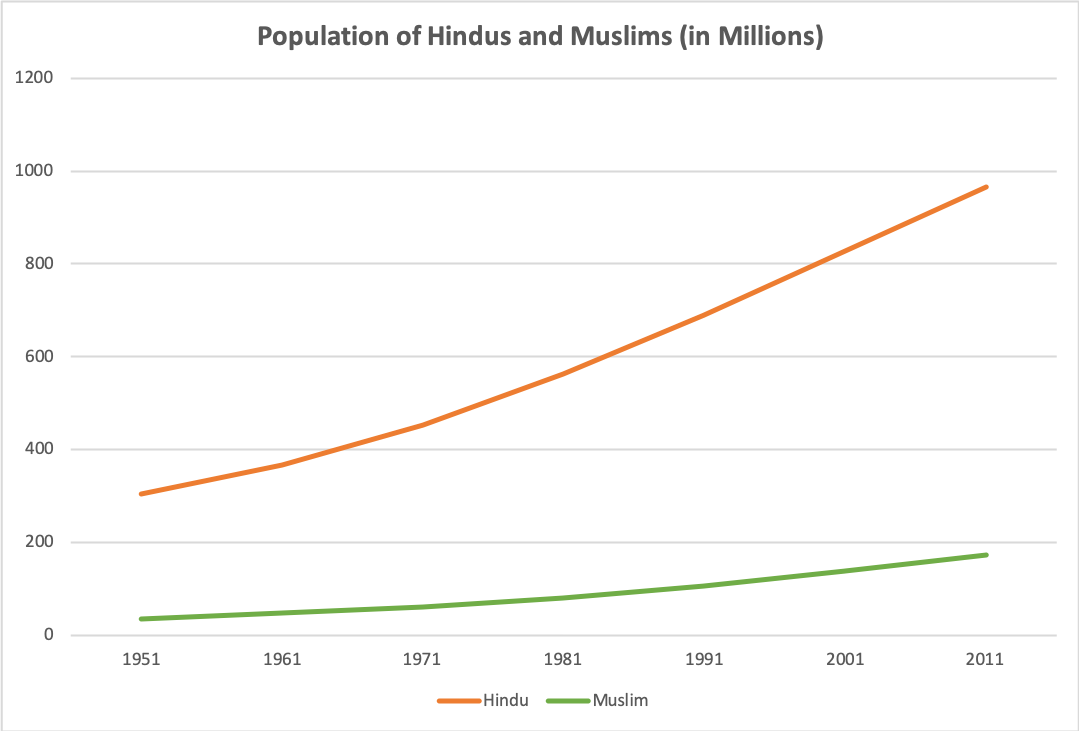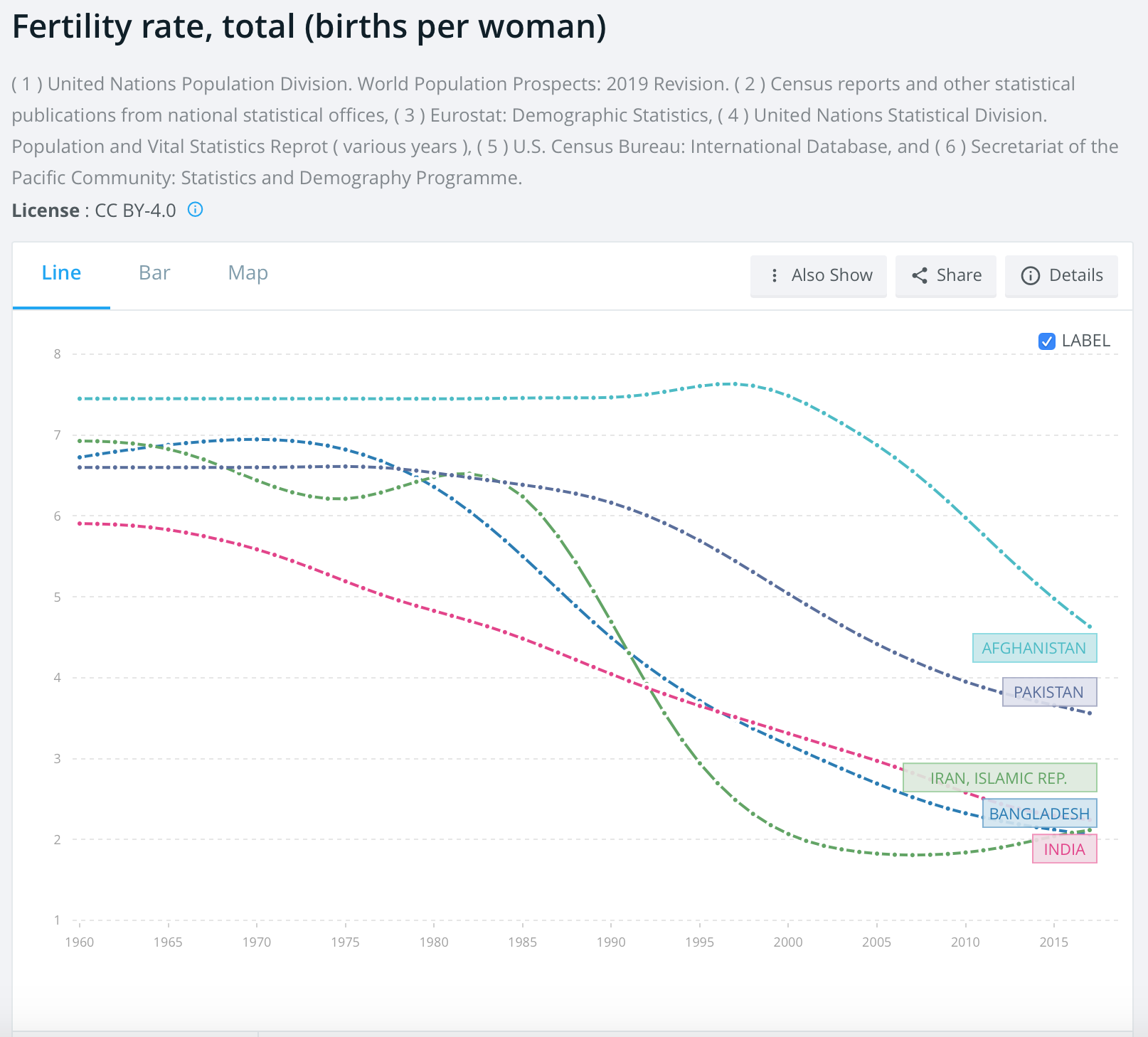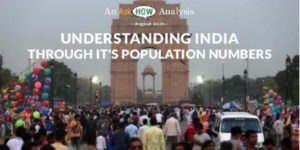Islam and population growth in Indiafeatured
This is the fifth post in a series on population in India. The first four posts can be found here, here, here and here. Each post can be read independently.
Recently, a Bhartiya Janta Party leader asked Hindu women to have more children. Possibly, he was trying to exploit a sense of unease that many non Muslims feel about growth of Muslim populaiton in India. I have sensed this unease in many people in casual discussions[1]. In this post I want to tackle questions on Islam and population growth in the country.
The basics
Is the share of Muslim population in India increasing?[2] Yes, as can be seen from the chart.

Of course, if you look at the actual population of Hindus and Muslims since independence, you see that both have increased significantly.

As I have written in the first post in this series, the last 70 years have seen the whole world population explode and that India saw a growth higher than world average. The good news is the fertility has fallen in India as well as in the whole world. The latest estimates show that the fertility rates in India are nearly at replacement levels ( although the population is projected to grow till 2065 as I have explained here). How have been the growth rates for Hindu and Muslim populations? The following table details the decadal growth rates

As can be seen,
- The growth rates have fallen for both communities.
- The decadal growth rate is higher for Muslims as compared to Hindus.
Do Islamic societies always have a high population growth?
Is there anything intrinsic to Islamic societies that keeps their population growth rates at high levels? To answer this question, I looked at fertility rates of some countries that have a predominantly Muslim population[3].
Many Islamic countries do have a high fertility rate. According to the World Bank, in 2017, the fertility rate in Pakistan was 3.6 and in Afghanistan 4.6! However, equally importantly, there are many Muslim majority countries with a low fertility rate. For example, the Islamic Republic of Iran had a fertility rate of 2.1 as did Bangladesh. Interestingly all these countries had a fertility rate in excess of 6 in the 1960s.

Within India too, Jammu and Kashmir had a total fertility rate of 1.6 as per the latest Sample Survey. It may be remembered that approximately two thirds of the state’s population is Muslim.
So, clearly the religion of Islam is nowhere near being the primary driver of population growth rate. What are the main drivers then?
What does fertility depend on?
Hans Rosling – in this video – explains that the fertility rate in a society depends primarily on childhood mortality. Parents decide to have more children if there is a danger that many of their kids would die in childbirth or at a young age. Big reductions in fertility happen when very few young children die.
Other factors also help in reduction of fertility rates. For example, urbanisation, female education and empowerment and easy access to methods of contraception. And these factors are likely to be correlated. A relatively prosperous society is likely to be urban and to have medical facilities that reduce infant mortality. The women in such a society are more likely to be educated and empowered and it is also likely that contraception methods are more easily available.
So any Indians worried about high growth rate of Muslims in India should be thinking of same solutions as they would for high growth rates in non Muslim population. That is, reduction in childhood mortality, prosperity, availability of contraception and women’s education and empowerment.
Are there reasons that slow down the reduction in fertility? Researchers have argued that religiosity is one of them. That is, “women who report that religion is “very important” in their everyday life have both higher fertility and higher intended fertility than those saying religion is “somewhat important” or “not important.” Do note that high religiosity of women in all religions leads to higher fertility according to these studies.
Does this contradict my previous assertion that the predominant religion in a society has nothing to do with big reductions in fertility? Not really. What I am saying is that large reductions in fertility happen when society reduces infant mortality, empowers women and makes contraception easily available. However, after such big reductions have taken place, research indicates that religiosity of a woman predicts her fertility.
Summary
- The share of Muslim populaiton in India has grown.
- However, it is in the context of sharp growth of population of all religions.
- High growth rate is not intrinsic to Islamic societies as cross country experience shows. As does the experience of Jammu and Kashmir in India.
- Sharp fall in fertility happens with reduction in childhood mortality. Other factors are prosperity, urbanization, women’s education and availability of methods of contraception. Religiosity could contribute to a higher growth rate.
So, with low level of population growth as a goal for our country, we should be focusing on reducing childhood mortality and increasing urbanization, women’s empowerment and easing availability of methods of contraception for everyone.
________________________________________________________________________________
This is the fifth in a series on population. The first four articles can be found here
- Everything you wanted to know about population (but were too lazy to Google).
- Are the Acche Din of population growth already here?
- Chhath — the new national festival?
- Economic migration in India – The Who, the Why and other good stuff.
Author –
Yogesh Upadhyaya
(Yogesh Upadhyaya is one of the founders of AskHow India. Blogs are personal views.)
You can follow AskHow India (@AskHowIndia) or me (@Uppi89) on twitter or me on LinkedIn
[1] This post, and other posts in this series are written from a positive (what is) and not a normative (what should be) point of view. So I would not judge the apprehension people have of possible domination of Islam and merely enquire about what is the real situation. The only normative assumption is that in general, a low population growth rate is good for society.
[2] The data for the first section is from this post is from Wikipedia (https://en.wikipedia.org/wiki/Demographics_of_India, October 9, 2019). Calculations and charts are mine.
[3] DIfferences in fertility (and consequent differences in growth rates) are not the only way the population shares of religion changes. Immigration is another. Professor Chinmay Tumbe, in his book India Moving, has said that India was a net immigrant in the years 1970-2011. A very high number of these immigrants would have been from Bangladesh to the neighbouring states of Assam and West Bengal. This immigration would also have changed the religious demography of the two states and has definitely impacted the politics. I will tackle this subject in a separate post.



